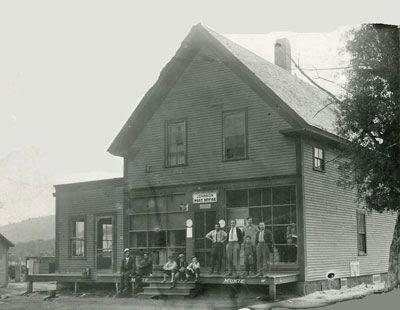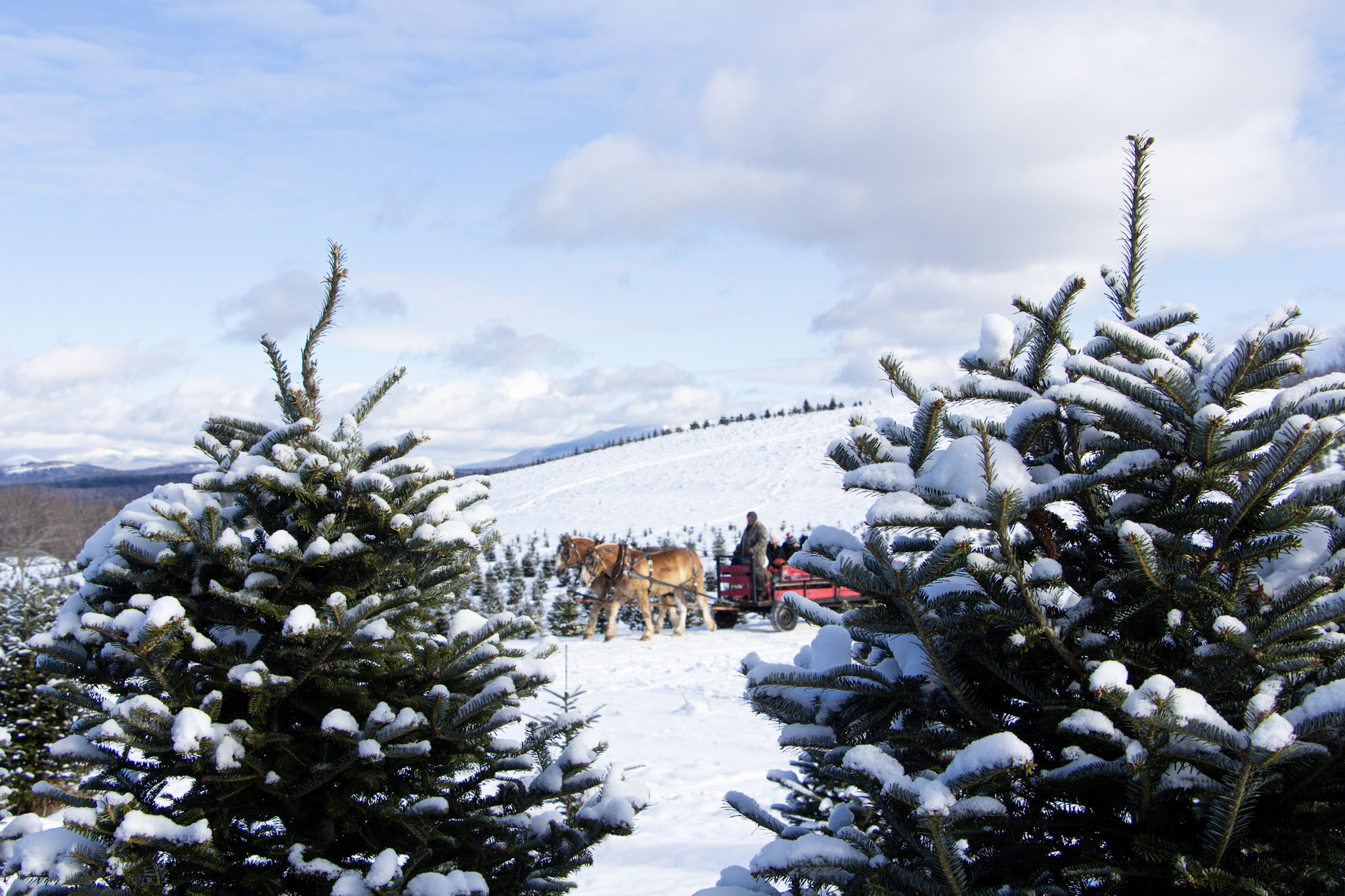- Tags:
- Land Conservation,
- Education,
- Forest Journal

Johnson, N.H., named for infamous logger G.L. Johnson, was a company town with a general store (pictured), a school and several houses for employees.
The west is the best. The western White Mountains have long been my personal favorite: less crowded, scenic villages and quieter hiking trails to explore. A classic daytrip starts at Plymouth on NH Rt. 25 following the Baker River Valley west to NH Rt. 118 north over the shoulder of Mt. Moosilauke to reach Rt. 112 at Kinsman Notch and Lost River and east to North Woodstock and Lincoln for a scenic tour. When sultry summer weather reigns, a visit to Lost River in the western White Mountains delivers elevation, scenic views, cool gorges and scenic cascades. Celebrate your adventure at a local ice cream shop or find a cold beverage in North Woodstock, Lincoln or Plymouth.
Lost River makes for an ideal destination for exploring nature, history and culture. The Society for the Protection of NH Forests protected this scenic natural wonder in 1912 as its first-ever Forest Reservation. Kinsman Notch is also rich in history as the 20th century White Mountains shifted from the railroad logging era to contemporary recreation tourism.
Lost River
Lost River is a place where, as the iconic Led Zepplin song lyric suggests, “the forest will echo with laughter.” Lost River has thrilled summer visitors for more than a century. The cool, shady gorge features cascading waterfalls and natural boulder caves. On hot summer days, temperatures in the valley may reach eighty-five degrees but the gorge remains in the sixties – Nature’s air conditioning. The unique one-mile boardwalk with stairways provides passage through mossy granite walls to access eleven different caves where Lost River plays hide and seek amid and underneath boulders. These caves are optional as boardwalks offer a bypass option around each.
Lost River is a family summer tradition. Multiple generations often reminisce while re-experiencing caves with names like “Lemon Squeezer” “Center of the Earth” and “Cave of Silence” - try that one with children? Incredulous visitors from afar have asked the Lost River gorge guides “Are these rocks real?” and “Do you turn off the water at night?” You might laugh, but in a world of digital distractions, artificial theme parks and adventure rides, many people have never had an opportunity to experience a unique, 100% natural setting like Lost River. The alchemy involves quality family time together outdoors in Nature while unplugged from screens. Yet don’t ditch the phone entirely, because Selfie photo opportunities abound. Lost River is fun, safe and family-friendly including the Forest Adventure Trail, treehouse pavilion, suspension bridge, covered bridge, a giant bird nest and observation platforms with stunning views from steep-walled Kinsman Notch looking east down Lost River valley to the heart of the White Mountains.
Just 125 years ago, Lost River was a last frontier of a fading White Mountain logging empire. The conservation pioneers who founded the Forest Society began to lobby to create a National Forest in NH and witnessed the transformation of the grand hotel summer resorts to the vibrant recreation tourism industry across the region today.
Colorful history: Railroad Logger G.L. Johnson
Founded in 1901, the Forest Society will soon celebrate its 125th anniversary. The purchase of 152 acres in March 1912 at Lost River was the first permanent conservation property owned by The Forest Society which today owns 200 properties totaling 68,000 acres. The land at Lost River was donated by Publisher’s Paper Company. The Mattson Manufacturing donated its hardwood timber rights. However, the Forest Society needed to purchase the more valuable rights to red spruce timber owned by an infamous logger, George L. Johnson. Living up to his shrewd reputation, Johnson drove a hard bargain, negotiating the sale of the softwood timber rights for $7,000. The Forest Society’s purchase was made explicitly to protect remaining old growth and with a goal to improve public visitation.
Today, Lost River is surrounded by the White Mountain National Forest and the tract includes relict old growth yellow birch and red spruce forest amid boulders below steep talus slopes at the foot of Dilly Cliffs and the most inaccessible recesses of Lost River gorge. Trees that G.L. Johnson calculated he could never extract from the rugged and inoperable Lost River tract are the last vestiges of old growth left at the close of his logging empire. According to Rick Russack writing for The Upper Pemigewasset Historical Society, G.L. Johnson built and operated a logging railroad, known at the Gordon Pond Railroad incorporated in 1907. The track was leased from the Boston and Maine Railroad, which served the valley's nascent tourist trade. “Logging railroads provided a profitable flow of freight for the B&M, so they often leased track and other equipment to loggers. The Gordon Pond Railroad eventually owned15 miles of track, mostly to the west of the Pemigewasset River, although some track did run north to Indian Head and the Flume. Johnson's land holdings extended west to Lost River”
G.L. Johnson literally built a town he named for himself. “Johnson, NH” had its own post office and appeared on 1900-era maps. The town was located where the Indian Head Resort is today. Johnson's sawmill was capable of cutting 65,000 feet of lumber per day. His logging railroad operated four Shay-geared locomotives. The company town also had a general store, school and several houses for employees. “The town of Johnson, NH was short lived, and very little of it survives today. The schoolhouse has been moved and is today a private residence. Logging was over by 1915 and the mill burned in that year and the rails were taken up that year. During it's short life, the Johnson Lumber Company cut about 150 million board feet lumber.”
Johnson operated a second sawmill, he first leased and then purchased from Publisher's Paper Company located on the Lost River Road, NH Rt.112 located where the Lost River Campground is today. Before 1912, the logging advanced from this western outpost into the remote, rugged terrain of Kinsman Notch to access virgin red spruce timber. Today the Appalachian Trail crosses the floor of Kinsman Notch, the watershed divide between the Wild Ammonoosuc River flowing west to the Connecticut River and Lost River flowing east to the Merrimack River.
Logging on Mount Moosilaukee and along the upper Wild Ammonoosuc River at Wildwood and Bungy included a series of small impoundments called “squirt dams” to build a sufficient head of water to flush logs west downstream to mills at Woodsville and points further south on the Connecticut River. To the east of Lost River, the second G.L. Johnson Lumber Company sawmill operated from 1904 to 1916 in Woodstock.
The underlying land at Lost River was owned by the Publisher’s Paper Company, which had conveyed all the timber rights to G. L. Johnson. Johnson drove a shrewd bargain with the Matson Manufacturing Company of Pennsylvania, selling them the rights to relatively worthless yellow birch in Kinsman Notch while retaining rights to the more lucrative red spruce timber. In that era, hardwood timber – used for making wood specialty products: furniture, bobbins and spools for the textile industry – was considered less valuable than tall, straight higher-volume red spruce timber used for manufacturing lumber.
Forest Society forester, J. Willcox Brown wrote in the Forest History of Mount Moosilauke that Johnson was “perhaps the smartest logger to ever set foot on Moosilauke. Esteemed ‘a shrewd old cuss,’ he was reputedly so crooked he could hide behind a corkscrew.” During the first decade of the 1900’s the Johnson sawmill operated on borrowed capital in the form of rails and rolling stock for construction and operation of “a sturdy economical logging railroad to access virgin red spruce in Kinsman Notch and the surrounding valleys of Mt Blue and Mt Moosilauke. The ‘Titan of the East Slope’ G.L. Johnson paid off his entire debt in the first winter by delivering all of the logs he cut to the larger James J.E. Henry sawmill in Lincoln. Johnson then cut timber owned by the Woodstock Lumber Company to build his own thriving lumber empire complete with a large steam mill at the foot of the brook flowing from the north slope of Mt Moosilauke.
More railroad construction followed: west up the steep hill to Lost River and south to logging camps at Mount Cilley and Elbow Pond. For eleven years from 1903 to 1914, Johnson’s “artful” logging camp walking boss was “Jakey” McGraw whose innovative logging exploits are legendary. From beaver meadows at the height of land, the last of the tall red spruce timber was blocked by a vertical black crag jutting off Moosilaukee between Beaver Brook and Stark Brook Falls. Jake McGraw built a logging road around the base of the crag and then up the steep Stark Falls valley. According to J. Wilcox Brown, McGraw explained how he installed a cable drum at the upper terminus to lower logs to the meadow below with the logs snubbed back with an endless wire rope the (horse) teams could slide safely on their haunches down the steep slope. McGraw is alleged to have said “They sure looked handsome. Like they were ready for a fancy drive with the long sticks a-rearin’ up behind them.”
J. Wilcox Brown adds one poignant postscript: “G.L. Johnson lived to regret but one business mistake. In March 1912, the Society for the Protection of NH Forests acquired title to a tract in Kinsman Notch including the famous caverns and ledges to the north. The ledges bore a scattered stand of old spruce which even McGraw did not believe he could log, so Johnson thought he was driving another shrewd bargain when he gracefully relinquished his claim to the stumpage involved for a substantial amount of cash… Several years later, in 1916 he visited the thriving new project at the height of the summer season. After sitting all day in subdued observation of the throngs paying twenty-five cents admission to the caverns, he turned to Michael McCarthy, superintendent of Lost River Reservation and said, “Mike dammit, I never should have sold this place, and I couldn’t see it.”
Rick Russack writing for White Mountains History website relates “in March of 1916, a surrounding tract of more than 30,000 acres once owned by Publishers Paper Company on the east slopes of Moosilauke and the Kinsman Range was sold to the US as an addition to the new White Mountain National Forest. By 1916, the town of Johnson was deserted. The large mill had burned in 1915, and since most of the available lumber on the leased lands had been cut, the mill was not rebuilt. The Johnson lands became the second parcel acquired for the newly formed White Mountain National Forest.”
